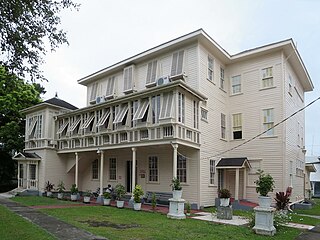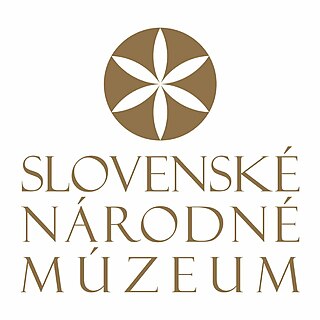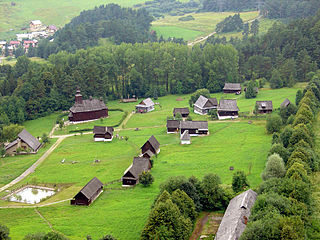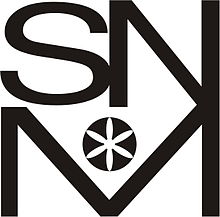
Robert Stewart Culin was an American ethnographer and author interested in games, art and dress. Culin played a major role in the development of ethnography, first concentrating his efforts on studying the Asian-Americans workers in Philadelphia. His first published works were "The Practice of Medicine by the Chinese in America" and "China in America: A study in the social life of the Chinese in the eastern cities of the United States", both dated 1887. He believed that similarity in gaming demonstrated similarity and contact among cultures across the world.

An open-air museum is a museum that exhibits collections of buildings and artifacts out-of-doors. It is also frequently known as a museum of buildings or a folk museum.

Matica Slovenská is the oldest Slovak national, cultural and scientific organization. The headquarters of Slovak Matica is the town of Martin, Slovakia as the center of the national culture of Slovaks, where it was founded in 1863 and revived in 1919. Slovak Matica is a public institution that operates as a national scientific and cultural centre. It has facilities both in the Slovak Republic and abroad. Slovak Matica works to develop and protect the national rights, identity, and development of Slovak culture and the Slovak nation. Slovak Matica is a legal entity. It establishes its organizational units on the territory of the Slovak Republic as well as abroad. The position and activity of Slovak Matica is regulated by Act no. 68/1997 Coll. on the Slovak Matica as amended and the Statutes of Slovak Matica.

The National Museum (NM) is a Czech museum institution intended to systematically establish, prepare, and publicly exhibit natural scientific and historical collections. It was founded in 1818 by Kašpar Maria Šternberg. Historian František Palacký was also strongly involved in the foundation of the museum.

The Walter Roth Museum of Anthropology is a museum of anthropology in Georgetown, Guyana and claims to be the oldest such museum in the English-speaking Caribbean region. It was established in 1974, but not opened to the public until 1982. It is located at 61 Main Street, North Cummingsburg, Georgetown.

The National Museum of Bosnia and Herzegovina is located in central Sarajevo, the capital of Bosnia and Herzegovina.

"ASTRA" National Museum Complex is a museum complex in Sibiu, Romania, which gathers under the same authority four ethnology and civilisation museums in the city, a series of laboratories for conservation and research, and a documentation centre. It is the successor of the ASTRA Museum that has existed in the city since 1905. Its modern life started with the opening of The Museum of Folk Technology in 1964, now The "ASTRA" Museum of the Traditional Folk Civilization.

The Slovak National Museum is the most important institution focusing on scientific research and cultural education in the field of museology in Slovakia. Its beginnings "are connected with the endeavour of the Slovak nation for national emancipation and self-determination".

Slovakia has around 14 open-air museums, or skanzens, showcasing the country's folk traditions, architecture, and economic history. The museums include examples of traditional buildings and furnishings, and many offer demonstrations of traditional handicrafts. The largest open-air museum is the Slovak Village Open Air Museum in Martin.

The National Museum of Ethnography is a museum of ethnography in Warsaw, Poland. It was established in 1888.

The large open-air Museum of the Slovak Village is situated on the outskirts of the northern city of Martin in Slovakia.

Zora Mintalová-Zubercová is a Slovak ethnographer, historian, museologist and popular science author, best known for her study of food history and material culture of Slovakia and the history of the Slovak Red Cross. Her work has, among others, earned her the Pitrè Prize as well as the National Medal of Science of the Slovak Republic.

Akaki Chanturia was a Georgian scientist, archaeologist and ethnographer. Educated primarily in England, where he lived from 1904 to 1920, Chanturia returned to his native Samegrelo to established the Dadiani Palaces Museum in Zugdidi.
Hermann Goetz was a German art historian and museum director, known for his scholarly contributions in the field of Indian art history. He was the Director of the Baroda Museum & Picture Gallery, and the Director of history of art at the Heidelberg University's Südasien-Institut.

The Museum of Cieszyn Silesia in Cieszyn is one of the oldest public museums in Central Europe and the oldest public museum in Poland, set up by father Leopold Jan Szersznik in 1802.

Maria Znamierowska-Prüfferowa (1898–1990) was a Polish ethnographer, professor at the Nicolaus Copernicus University in Toruń, founder and long-term director of the Toruń Ethnographic Museum, named posthumously after her. She was also an activist of the Polish Ethnological Society.





















